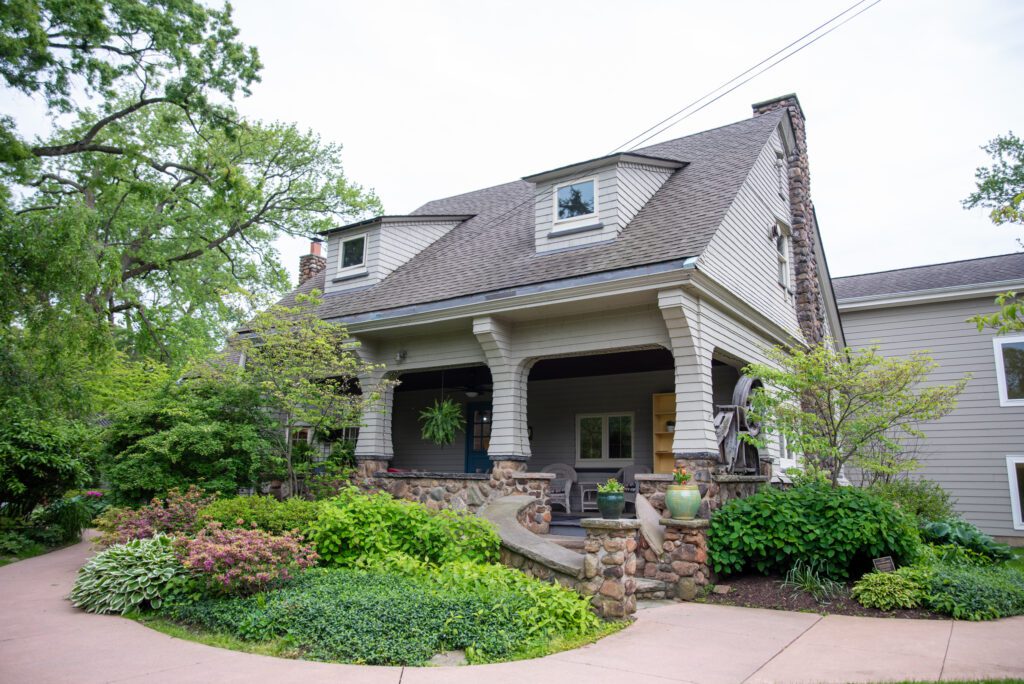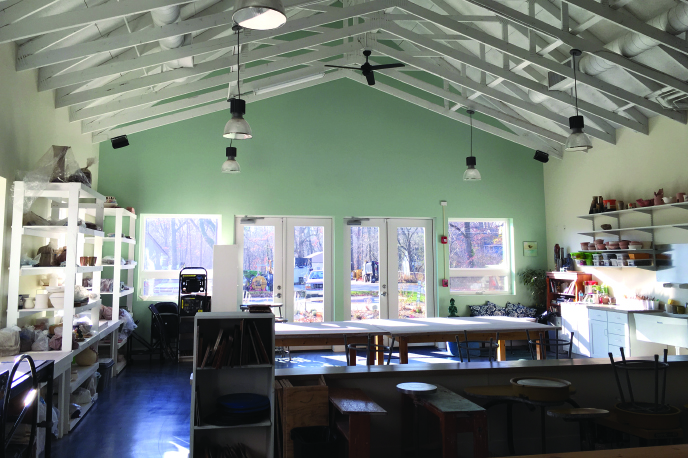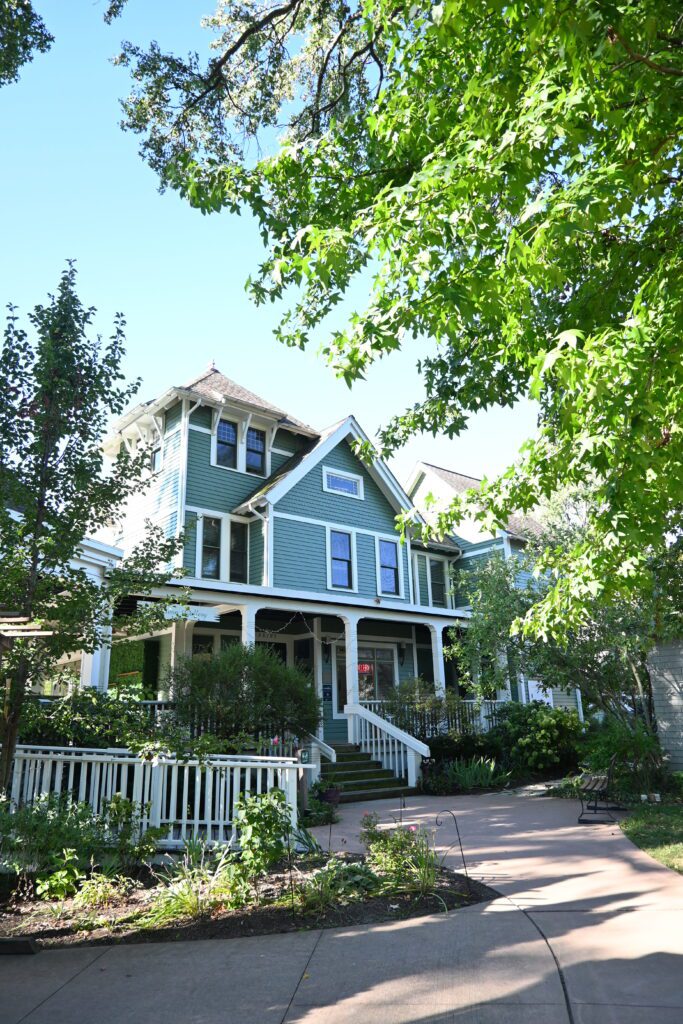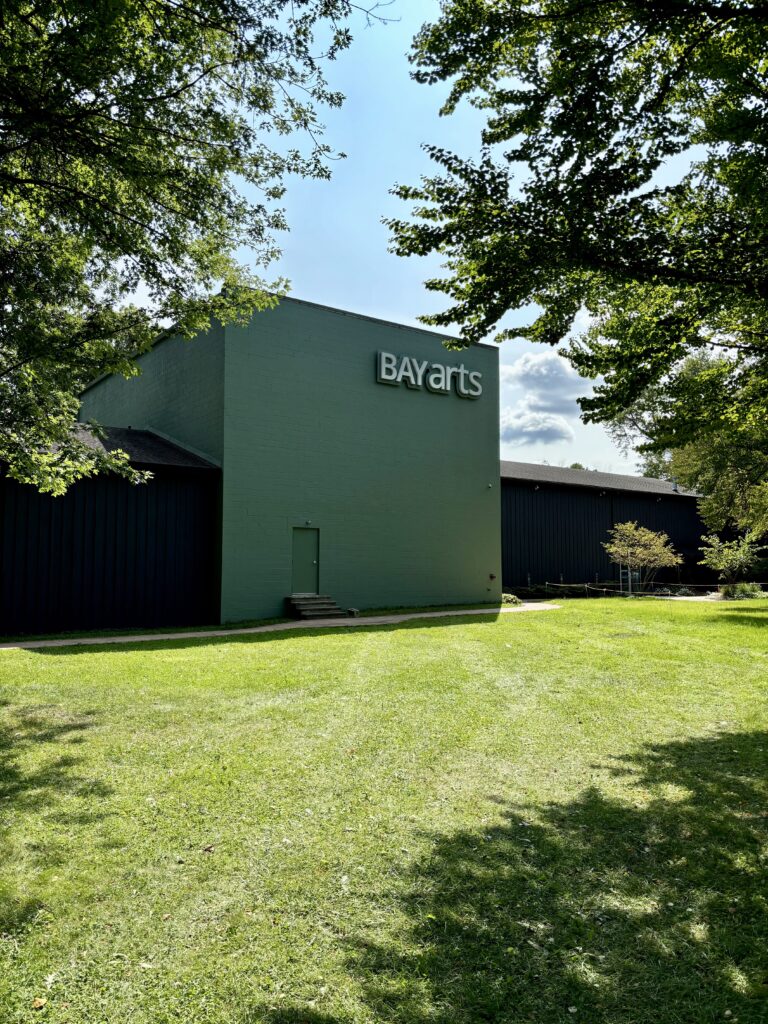Artistic by Nature
About BAYarts
The mission of BAYarts is to provide a welcoming lakeside environment to stimulate, encourage and support professional and aspiring artists of all ages through collaboration, education and exhibition.
BAYarts campus is within walking distance of Lake Erie Nature & Science Center, a frequent collaborator, and Huntington Beach. Nearly one million visitors enjoy the Lake Erie shore on the northern end of the reservation each year.

BAYarts is in the Huntington Reservation in Cleveland Metroparks, located in Bay Village near the border of Cuyahoga and Lorain Counties. The BAYarts campus includes the John Huntington House, the Irene Lawrence Fuller House, the Station House leased by Chatty’s Pizzeria, the Sullivan Family Auditorium (formerly the Huntington Playhouse), and an historic caboose. The 100 acre park, known as the Huntington Reservation, was formerly the summer estate of John Huntington, inventor, industrialist and key founder of the Cleveland Art Museum. It was purchased by the Cleveland Metroparks in 1925 and became the home of Baycrafter’s (the predecessor to BAYarts).
HISTORY
In 1948, a group of Bay Village women formed a local arts organization dedicated to stimulating interest in arts and culture in the rapidly growing suburbs in Cleveland’s west side communities. Originally located in two rooms in the basement of Rose Hill Museum, the organization provided quality arts education by the area’s finest instructors. The group also hosted exhibits that provided local artists with the opportunity to showcase and sell their works.

The Station House
Built 1882
As the organization grew, they began to search for a home of their own. In 1962, Baycrafters was able to secure an old Bay Village landmark – the old station house, originally located at the junction of the Nickel Plate railway and Dover Center Road. The Victorian-style train station, built in 1882, was donated to Baycrafters by the New York, Chicago and St. Louis Railroad Co. The Cleveland Metropolitan Park District (as it was known back then) agreed to allow the station house to be moved to the north end of the Huntington Reservation, in between the old Huntington Carriage House (what became the Huntington Playhouse) and the Caretaker’s House. The Station House was moved by truck from its original location to the park, traveling down Dover Center to Lake Road, south on Longbeach Parkway, entering the park via the park entrance at Northfield Road. The Station House is now home to the popular Chatty’s Pizzeria.
The Huntington House
Built late 1800s
This classic bungalow-style house was once home to the caretaker of the John Huntington estate. Built in the late 1800s, the house is one of the only remaining structures original to the Huntington estate. The Cleveland Metropolitan Park System purchased the estate in 1925 for $500,000 and named it the Huntington House to honor the family legacy. The Huntington House remained a private residence until 1967, when the Baycrafters organization assumed occupancy and designated this space for its gallery exhibitions and additional classroom space.
Today, the Huntington House is home to the BAYarts gift shop, offices, and classrooms. In 2015, a state-of-the-art ceramics studio was added to the building.

Photo by Hilary Nemecek

The Karen Ryel Center for Ceramics Art and Education
Built 2015
In May of 2015, BAYarts opened a 2,500 square foot addition to the Huntington House. This state-of-the-art ceramics studio features 10 pottery wheels, 4 kilns and a spacious creative workspace. The new addition was named in memory of Karen Ryel, a ceramics artist and member of BAYarts close-knit ceramics community. Today, BAYarts students of all ages and skill levels are now able to enjoy the ancient art of ceramics in a fully modern space.
The Fuller House
Built 1800s
Originally built on a high bluff above Lake Erie on the eastern end of Bay Village, the 130-year-old Queen Anne style home was a wedding gift to Irene Lawrence Fuller from her father, industrialist and president of National Carbon Company, Washington H. Lawrence.
In 1948, Dr. Richard Sheppard of the Cleveland Osteopathic Association purchased the Lawrence mansion. The group moved from Cleveland to Bay Village and renovated the mansion into Bay View Hospital, a modern (for its day) 85-bed facility. The Irene Lawrence Fuller House was used as the residence for Dr. Richard Sheppard and his wife. Shortly thereafter, Dr. Richard’s son, Dr. Sam Sheppard returned from California with his new wife Marilyn, to join his father’s practice at Bay View Hospital.
In the early morning of July 4, 1954, Marilyn Sheppard was murdered in the bedroom of their Bay Village home and the saga of the infamous murder case began. One August 2nd, on the front porch of his parent’s home (the Irene Lawrence Fuller House) Dr. Sam Sheppard was arrested for the murder of his wife.
The Bay View Hospital closed its doors in 1981 and developer Bob Corna purchased the hospital and surrounding land to create a condominium community named Cashelmara (Gaelic for “stone house by the sea”). The Fuller House was set to be demolished to make room for the new development. Former Baycrafters Director, Sally Price, led a community effort to save the structure and move it to the Baycrafters campus in the Huntington Reservation of the Cleveland Metroparks. On August 29, 1984, 120-ton Fuller House was transported via barge on a three-and-half mile journey, an unconventional move that drew international attention. The structure was installed on a new foundation on the Baycrafters campus, where the house sat vacant for many years.
New management in 2006, brought a fresh new creative vibe to the campus. Baycrafters was rebranded to BAYarts and fundraising efforts began to bring much-needed renovations to the now famous (and infamous) Fuller House.
In 2008, BAYarts was awarded a grant from the Ohio Cultural Facilities Commission. That grant, combined with financial assistance from the Cleveland Metroparks and funds raised through a capital campaign, enabled BAYarts to begin renovations in April of 2009. The renovated building opened to the public in October of 2010.
Today, the Fuller House is the centerpiece of the BAYarts campus. This Victorian gem with a storied past has found new purpose and is brimming with life. The interior is home to classrooms, office space and the esteemed Sullivan Family Gallery. Outside, the wraparound porch and surrounding gardens welcome patrons and visitors alike.


The Sullivan Family Auditorium
The Huntington Playhouse was established in 1958 and sits on the site of John Huntington’s carriage house. It started as a small summer theater and grew into a place with a 240-seat auditorium. The Playhouse had its last season in 2015. In the summer of 2017 BAYarts began working to clean out the venue. BAYarts is thrilled to be renovating the former Playhouse so it can be used for a wide range of cultural programming.
The first phase of renovations was completed in January of 2019 and included new electrical and fire safety systems. Improvements also included new bathrooms and windows, and drywall in the Hearth Room (previously the space used for intermission). BAYarts currently uses the renovated west end of the building for classes, concerts, and as community meeting room.
A second phase of renovations was completed in the summer of 2024, in which the auditorium was transformed into a multi-use space with the capacity to host concerts, plays, speakers, and more. The flexible event space will also be used for larger classes, weddings, and corporate events. BAYarts received a $500,000 grant from the Ohio Facilities Construction Committee (OFCC) and raised an additional $500,000 to begin Phase Two.
Further renovations to the building include the addition of two music rooms, a large classroom, a second set of bathrooms and a central hallway to facilitate accessibility throughout the building. Fundraising is ongoing for the next phase of improvements.
Today
Beginning in 2005, a volunteer-driven revitalization campaign led to the renovation of the historical campus buildings and grounds and new construction. In 2006, the name was changed to BAYarts to reflect the fresh programming and revitalized organization.
